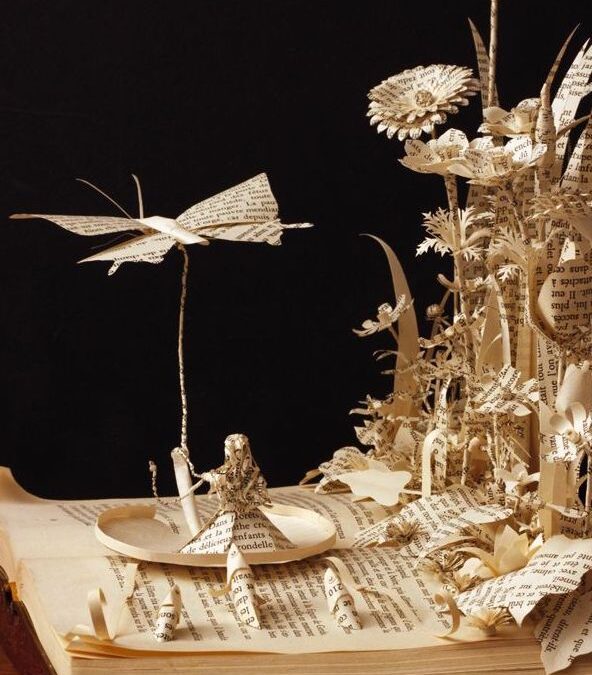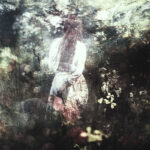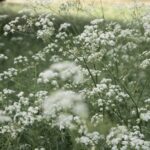Dear fairytale lovers & love walkers,
As I walk through the wonderful magnolia trees in their full blooms in our neighbouring gardens, I thought what a wonderful opportunity to today write about the flower girl herself, Thumbelina – a story written by Hans Christian Andersen. First published in 1835, Thumbelina holds within her pages the themes of love, of kindness and belonging; and I believe at its essence, it is actually a story about the importance of true friendships and of having someone who sees you as you truly are, rather than trying to mold you to fit their own ideas and narratives. For these reasons, I believe it holds importance for our modern world, society and culture.
To those of you new here, welcome; this is part of my Story Threads series, which you may read in my folklore, myth + fairytale section, where I share beautiful stories from around the world, and we unveil the wisdom hiden through the words and pages.
A little backstory & the story’s implications for our modern world
Many believe that Andersen based parts of the character of Thumbelina on one of his most faithful penpals and closest friends, a woman named Hanne Henriette Wulff. Their mutual letters still serve as major source of information for the author’s life; and she helped him translate many of his works in English. Wulff was tiny and frail, and loved travelling and the sea; and Andersen himself would portray her in his autobiography as almost his muse. As for Mr. Mole – it is believed that Andersen based this character on his former teacher, Simon Meisling, who repeated told him he’d never be a writer, calling him a stupid boy.
At a young age, Andersen had to support himself and worked as an apprentice to a weaver, and later, to a tailor. At fourteen, he moved to Copenhagen to work at a theatre, and there, a colleague of his encouraged young Andersen to continue writing, because he believed Andersen had a true talent, considering him a poet. Feeling encouraged, Andersen began focusing more seriously on his writing.
One of his earliest fairytales written was a tale called The Tallow Candle, which he had written while in school, and had dedicated it to his benefactors. The manuscript of the tale was discovered in October 2012, in the family’s archives, in a suitcase with documents belonging to the Plum family in a local branch in Denmark.
In The Tallow Candle, a tallow candle, whose parents are two pots, a sheep and a melting pot, becomes more and more disheartened as it cannot find a purpose in life. It eventually meets a tinderbox who lights a flame on the candle, and the candle finally finds its right place in life and spreads joy and happiness for itself and its fellow creatures. And I think this so beautifully portrays what Andersen essentially did in his life.
The humble truth is that he faced many challenges, rejections and criticisms throughout his life, but he persevered; he pulled himself up and didn’t lose faith, and along the way, he’d also have someone to help him, offer a hand, and encourage him when he needed it; we all need support and encouragement. He eventually became someone who developed his self confidence and self esteem, believed in his talents and gave them voice and hands; he created stories that hundreds of years later are still told and retold, touching people’s hearts from around the world. He often faced criticism that his tales weren’t the traditional “moral-full” tales for children, even though his tales are full of wisdom and morals; so he kind of created a gentle and quiet revolution in his storytelling – and re-imagined how tales can be written and told, in a way that they are understood by people of all ages – his tales are actually as much for children as they are for adults.
He shined a bright light forward, paved a new path, and gave voice to the voiceless and the powerless. And what I’ve always appreciated about his tales and writing style are his ability to portray the fragility and frailty of the human condition; because his tales almost give a grow-up adult experience within the childhood worlds of understanding also. He explored the many themes of the human emotions and their complex nuances, and gave voice to themes such as loneliness, struggle and disappointment. And when I meet people who think fairytales are all about happy ends, I know they are ignorant and obviously haven’t read many, and definitely not Andersen’s.
For those of you interested, I’ve previously written on his tales, The Snow Queen in What The Snow Queen Knows, and about The Little Mermaid in What The Little Mermaid Knows.
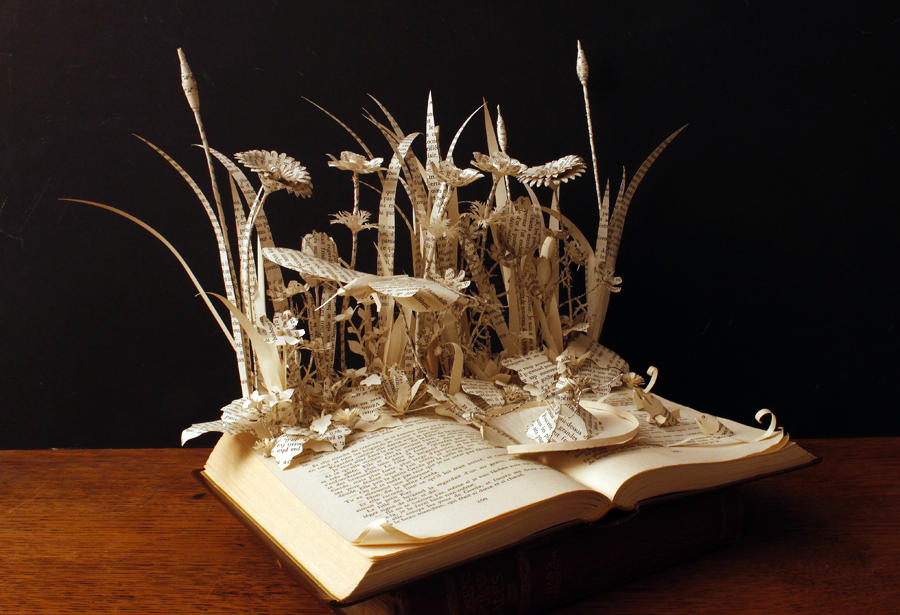
Beautiful art by Su Blackwell, her official website is linked here, portraying the tale of Thumbelina. All rights reserved by the artist.
Today’s tale Thumbelina is a happier and lighter one, and some might think of it as simple and ordinary, and truth be told I had to revisit it as I had perhaps only read once or twice in my life. And before sitting down to write I took some time to reflect upon it. I love diving deeper into things, into stories, especially those which I might initially think of as too simple – because I know from experience that all has its depth and wisdom – we just need to see it – and at the very least, there is always something new to learn, and expand in our perspectives.
In my desire to understand this tale better, I began reflecting upon its layers – what wisdoms does it hold, and how would it be relevant to our modern times? And the more I thought of it, the more I felt like this was a tale about something modern society actually misses, which is: true friendships. Surely, one of the main themes of Thumbelina is her coming into her true self – from a little seed into her full bloom; surely, this tale centers upon the importance of kindness, selflessness and belonging; but it is not so much a love or marriage story, as I believe it is about friendships.
I’ve had quite a few clients over the past years share with me how despite having many friends, networks and social circles, they actually don’t have one true friend whom they feel truly sees them, understands them, support them in the ways they need and selflessly. We live in a world where we are quite aware of many of our collective issues such as greed, selfishness, shallowness, avoidance, inability to invest and put in the effort, instant gratification, and extreme materialism; but what about the lack of true friendships? It seems there is an impoverished state of friendships, which has further contributed to the loneliness epidemic. I’ve spoken about this for years, for over ten years now, but I suppose it is becoming less of a blind spot now for people.
And one last thing before we begin with our tale today – I recently listened to a theologian, who shared about the letters of a medieval monk named Anselm; and in his letters to fellow monks from around the country and world, Anselm would often express deep passionate love and longing for his friends. He’d share how much he misses them, how much their minds and souls are entwined, and how important their friendships to him are. And he expressed all this to such an extend, that it led some modern contemporary scholars to think he had homosexual tendencies. The theologian didn’t agree, and neither do I. If anything, I think these so-called scholars are missing the mark.
I don’t find “his tendencies” to be of relevance at all, because for one, he was quite aware that his letters as a monk are public; and as such, if he wanted to express secrets regarding his romantic preferences or any other secrets, he wouldn’t ever share them in letters. But mainly, I find this more of a reflection on our own societal over-sexualization and impoverished state of mind of knowing what a true friend is. Perhaps it is precisely the loneliness and lack of true friends that leads people into over-emphasis on romantic love.
But love has many forms, family love, humanity love, romantic love, and certainly romantic love is a very important part and expression of love and how we deepen into our own selves and grow spiritually – but so are friendships. So I believe through this tale we can all reflect on what does a true friend mean in our life, what does it look like and feel like – and to remember to treasure our true connections, in whatever shape and way they come, because even one is a blessing, and one we must treasure deeply and be grateful for.

Thumbelina Illustrated by Milo Winter, c. 1916
A little summary
Thumbelina could not be a toad, because she wasn’t a toad. Thumbelina could not be a mole, because she wasn’t a mole. Thumbelina is Thumbelina, and that’s who she is. Along her paths, she faced various reflections of the selfishness and greed that exists within the human psyche; of those who wanted her to be as they wanted her, of their inability to see her as who she is; of their greed to keep her for themselves and make her fit whatever would serve them for their own benefit.
She began as a little seed, as we all do, and it takes time for us to come into our full bloom, and release our true fragrance, our true essence of who we are. As such, all twists and turns on the path are purposeful; they help us see who we are, and often to see who we are, we may need to see who we are not, or don’t choose to be through the way we choose to respond.
In time, she met a darling swallow, who needed help and warmth; and through Thumbelina’s pure kindness, stemming from her warm heart and selflessness, she helped the swallow in the way the swallow needed, and without expecting anything in turn for reward. It was precisely this kindness and selflessness that then rose her – on the wings of the swallow – and in divine order and divine timing, Thumbelina was led to the place where she belonged – to be surrounded by friends who saw her as she was, and supported her as she was, and to meet her flower-fairy prince, tiny and precious as she was. Her match. As he crowned her in marriage, he gave her the name Mayblossom, symbolizing her full bloom and her maturation into knowing who she is.
Let’s begin.

Thumbelina Illustrated by Nadezhda Illarionova. All rights reserved to the artist.
All begins with a seed
The first layer we unfold through the story are the seeds. A woman longing deeply for a child goes to a magic woman, and the magic woman gives her a seed to plant at home and care for. It is the woman’s loving hands, and her tending to the seed, that allow a girl to bloom in her shape as she is.
A rose is a rose is a rose. A rose cannot be an apple tree, nor can she be a blueberry. We are all as we are, and that’s precisely the beauty of it. We are all a poem, a unique melody. And as we unfold each of our petals, a new layer of us emerges in its true beauty – until our full bloom when we release our true, most natural and sweetest scent of who we are – of our true essence and spirit.
It all begins with a seed, and while as a seed it may look like some other seeds, there cannot be comparison – we are all unique, that’s the beauty of it. But the environment in which we are – the soil, the sun, the water, the caring hands – is what may allow us to bloom as we truly are.
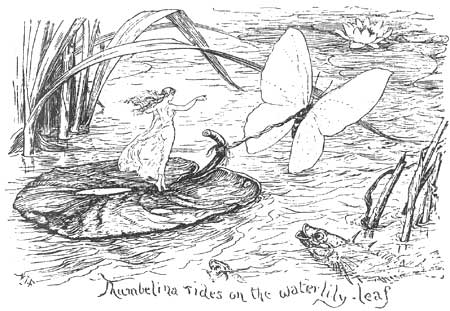
Thumbelina Illustration by H. J. Ford, c.1894
We plant many seeds in our life. We plant dreams, hope, visions – and then we tend to them, and we cannot allow the doubt of others to imprint on them. Nurture them with your trust, love and faith; speak them into sweetness with your words, and keep caring for them. Snowdrops grow in shade and in the middle of winter; and even when we can’t yet see them, they are there, shaping and forming in the soil – until one day, tempted by water, tempted by air, they will reach their hands through the soil for merging.
We can’t push seeds into the frozen ground in winter, flowers will not grow, it is not their time yet; we will only hurt them, and frustrate ourselves. To nurture means to tend to what already is beside you and in front of it. To nurture means to know the cycles of the land, and with kindness and patience of rhythm to shift your eyes and hands towards that which needs you now, in front of you, beside you. In spring, your hands will be needed elsewhere, and so it goes. When it’s time, it’s time. The past meets the future in the present, so stay present.

Thumbelina Illustration by E. A. Lemann
See what is by seeing what isn’t
We then travel through the twists and turns of life’s paths. No matter how many straight and direct roads we’d like to build as human beings, with concrete and highways, the paths of life are full of many twists and turns, and often shape in ways we just can’t see nor even understand. One night, Thumbelina is carried away in her walnut-shell cradle; and we too begin our travels, moved by the breeze, and the flow of life along its rivers.
And along life’s rivers, we too like Thumbelina face many things: some frogs, some mice, some help and warmth in our cold winters, and some selfishness and greed, and those desiring us to fit their own narratives and boxes. We hope to find belonging, we hope to find friends who see us for who we are, but we often face shallownes and falsity. And yet – we see what works sometimes by seeing what doesn’t; we see who we are by seeing who we are not; we see what we are made of by seeing how we respond to things, what we choose to do, and what we choose to weave through our own fingers.
We begin to shape and form things through our lips, hands and gestures – and this is what makes us. We unfold our own layers of self; we peel the layers of our bark until we release our own true fragrance. And even when things feel disappointing, perhaps it is precisely through this that we are able to peel yet another layer of ourselves – and see what we are made of and whom we choose to be.
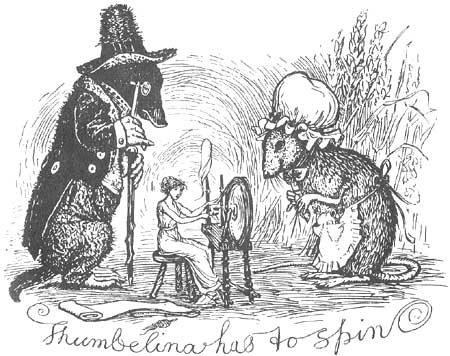
Thumbelina Illustration by H. J. Ford, c. 1894
We learn what we want and need by often seeing what we don’t want and don’t need. And that’s important. Thumbelina cannot be a frog, because she isn’t a frog. Thumbelina cannot marry a mole, because she isn’t a mole. Thumbelina cannot be that which is not – and she cannot bear the thought that she will stay underground because that’s not her home. It’s not where she belongs.
It is of course difficult to know where we actually belong sometimes. If all we ever see around us is mud, because we think we are of it. If all we ever see around us is apple trees, perhaps we think we are an apple tree. Apple trees are beautiful, but if we are not an apple tree, we can’t be an apple tree. Our perspectives in life, and of life, and of ourselves, are shaped upon our beliefs and what we’ve see and heard and witnessed.
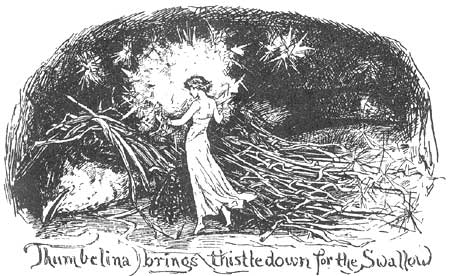
Thumbelina helps the swallow heal by bringing some thistledown to warm it in winter, Illustration by H. J. Ford, c. 1894
There is nothing wrong with being a frog, a mole; nor is there anything wrong with mud – this is the home and roots of the beautiful lotus flower. But a frog needs a frog, a mole needs its counterpart mole – otherwise they themselves will not be happy. If you love dancing with the flowers in the sun, you need to choose the one who’ll dance with you there also – so that both of you can share in your happiness.
We can’t force anyone to belong somewhere where they just don’t. It’s not love to take someone or push them to be happy where they aren’t. It’s not fair to them, and it’s not fair to you also; because you too will not be happy that way. There’s no place for selfishness in love. Within the context of our human relationships, sometimes people may still love each other, but if they are not on the same “wavelength”, they can’t sustain their relationship. It’s a truth that humbles us, and perhaps in time, after they’ve walked their own paths, they can reunite, but we can’t force things.
We all want to belong but it is important to know who we are and find what’s right for us. Who Thumbelina was is someone of kindness and selflessness, she is a flower girl, and she belongs with the flowers and sunlight.
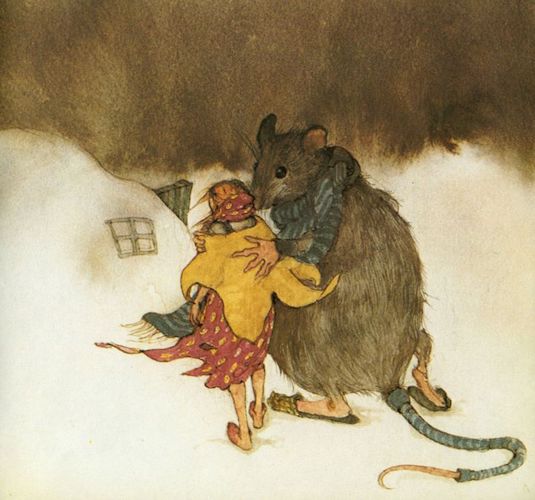
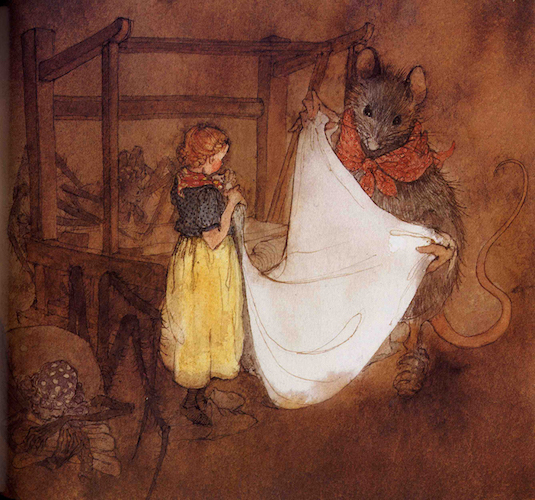
From the book Thumbeline, illustrated by Lisbeth Zwerger
It is love
What turns us and moves us, back into our sphere of being, back to that great magical dance that joins us to our home and heart, to each other and to other little creatures and animals – it is love. And it’s not some abstract nor over-used meaning of that word, because empty loves are thrown around a lot nowadays, but what I mean is a particular love for particular things, place, people, requiring of us acts and gestures in tangible ways with tangible effects. And this implies a responsibility rising out of generosity.
Only the action that is moved by love for the good at hand has the hope of becoming generous and responsible. And in our tale today, there is a moving – across seasons, across little creatures and places and things; some hands moved not of generosity, but others did, and it was love that moved them, and it was this that led to holding more love, more hands, more togetherness.
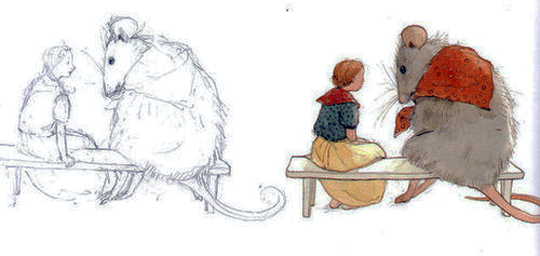
From the book Thumbeline, illustrated by Lisbeth Zwerger
Wisdom set in snow
Winter particularly is a very important season in tales, and in life. You see, our knowledge of winter is often kind of like a fragment of childhood, it is almost internal, innate, intuitive. We often learn about it in some magical way from stories and fairytales by the fire, the books we were read when it was too cold outside to play, the squishing of our boots in snow, the mysticism of snow and dark starry nights, and even the magical anticipation waiting for Christmas.
It’s a knowledge set in snow; and it is almost alchemical. We see animals endure the cold foodless months, we see the limitations, the hibernations, the migrations, and the bared branches of the tree asking for absolute honesty. All these changes we witness are kind of an alchemy, because in winter we witness the pure strength and courage of spirit, the endurance and the faith and trust. It’s no easy thing. There’s no pretense in winter; there is nowhere to hide, nothing to deny. We adapt. We prepare. And sometimes we perform extraordinary acts to get through.
It’s a knowledge, and wisdom and trust, gained in snow. And this is when we see what we are truly made of. We see how far we’d go to help someone who needs us even if we have nothing to gain from it; and we see how far we’ll go to warm a little swallow, who may not even be able to thank us at all, and yet we’ll go and warm it and feed it, even when we think there is absolutely no chance for her. Because that’s who we are. It’s a strength, and faith and love, gained in snow.
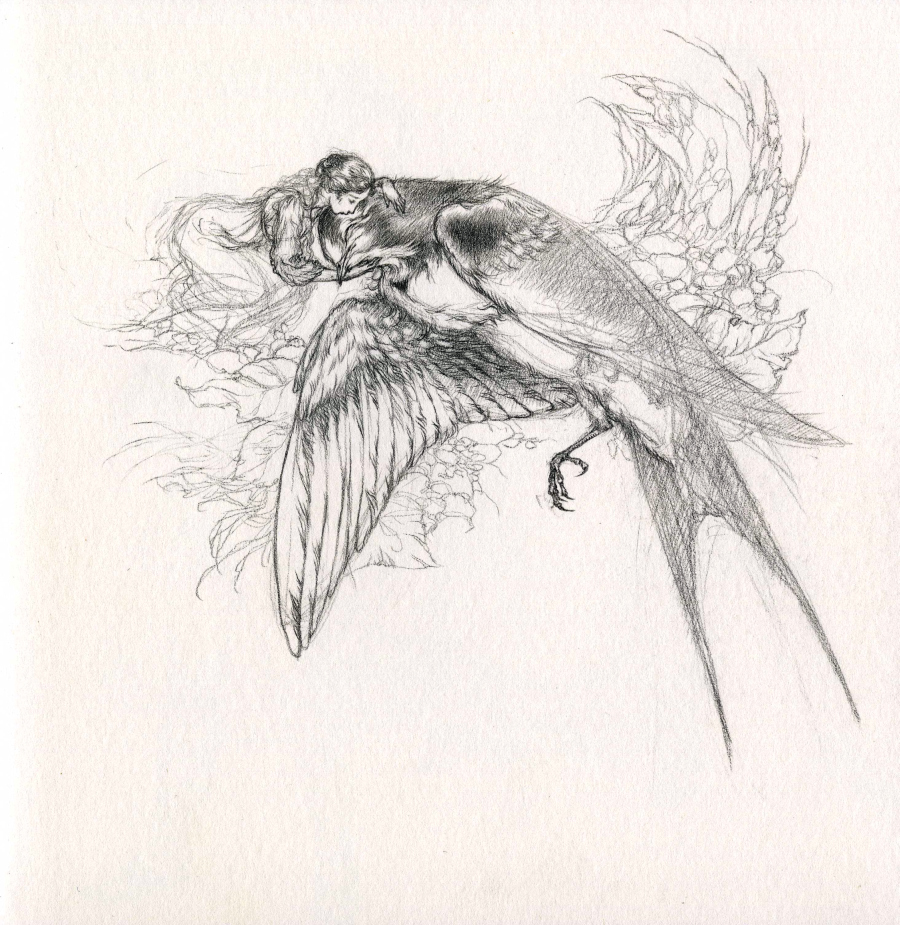
I love this illustration of Thumbelina and the swallow; I don’t know the artist’s name, his nick name is himmapaan, and in honour of Hans Christian Andersen’s birthday, he had drawn this and posted it here. All rights reserved to the artist.
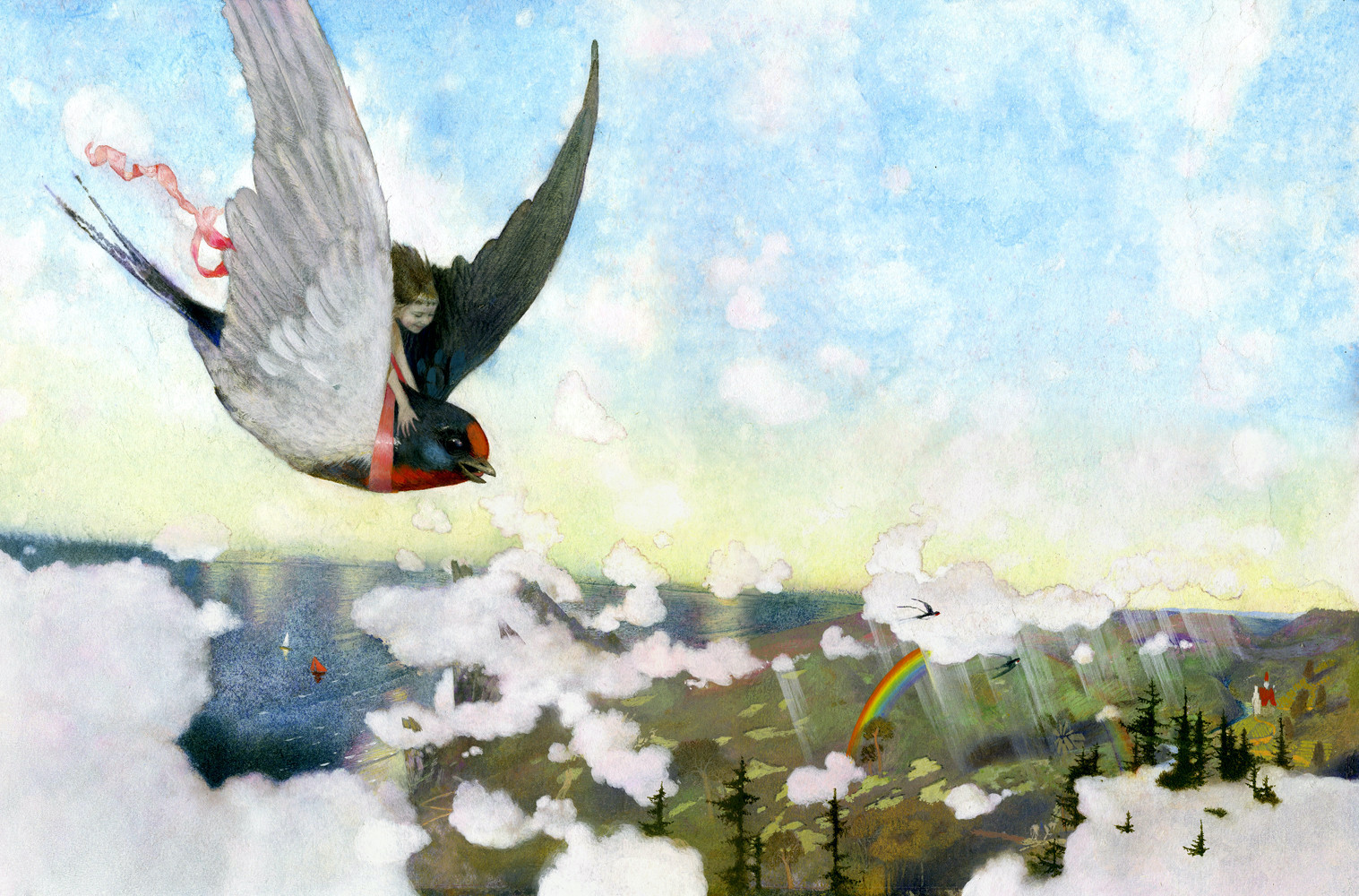
Thumbelina Illustrated by Nadezhda Illarionova. All rights reserved to the artist.
On the wings of who you are
And one day, during the thick of freezing winter, Thumbelina meets an injured swallow, and out of her selflessness and kindness she helps the swallow heal by bringing it some thistledown to warm it, and she cares for it all winter. Thumbelina helps the swallow not in the way she thinks or wants to be given in turn, but in the way the swallow needs her to.
Often times in relationships and friendships, we give to another what we want to be given or think we should, rather than what the other person actually needs. To love is to pay attention – and give to another what they need, and to accept them for who they are, and to give them the space within which they can be who they are as they need to, as they are. A relationship is a ring, a circle, within which we can evolve – but we evolve within it; and as such, we need the right space and the right person.
Love is a seeing not of flesh, but through the flesh. We can only be with the right person if we are our true self; masks cannot fall in love. Intimacy and deep love require opening of hearts and undressing the layers.
In the same way, when we are our true selves, it may be harder to find our true “tribe” but we shouldn’t stop being our true selves. I meet many clients who share how difficult it is to find true friends – and how most of their friendships feel shallow, as if they can’t share in deeper conversations, walk on egg shells, or just don’t feel truly seen nor heard nor understood. And as I wrote in the beginning, it seems to me that in our modern world today one of the things we may miss as a collective is a true friend.
And now back to our story,
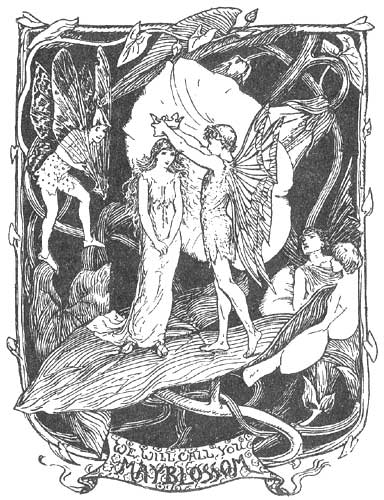
Thumbelina finds and re-unites with her flower-fairy prince, Illustration by H. J. Ford, c. 1894
Full Bloom
Out of her purity of heart, kindness and selflessness, Thumbelina rose. She rose in spring upon the wings of the swallow, being taken to where she belongs, and into the arms of the one she was made for. A flowery-fairy prince, just tiny as she, who too loved dancing among the flowers, singing with the suns and stars and moons – someone who spoke her language, the language of her heart.
As they married, he gave her the name Mayblossom, symbolizing the full bloom of our little flower maiden. She began as a little seed, walked the paths and learned about herself, learned how much she loved the sunlight and dancing with the flowers, and as all of us fellow little seeds do, she came into her full bloom – she blossomed into who she truly was.
And the swallow? Well, our darling match-maker of spirits flew all the way to a little house in Denmark, where she told the story to a man called Hans Christian Andersen – who in turn, gave life to the story through his pen.
My favourite re-telling of Thumbelina is actually Shelly Duvall’s Faerie Tale Theatre’s adaptation, where the fairy prince knows how much Thumbelina really misses her mother; and so before they marry, he sends the swallow to bring her mother to their fairy land – the two embrace and are reunited, and they all live happily there after!

Thumbelina Illustrated by Nadezhda Illarionova. All rights reserved to the artist.
What Thumbelina knows is that we can never stray too far from who we are; we just need to walk with patience and kindness of rhythm as we come into our bloom of who we are.
What Thumbelina knows is that kindness holds us, raises us and lifts us; and that what we shape through our lips, hands and gestures becomes who we are and paves our path forward.
What Thumbelina knows is that like rivers flow to sea, what is will always be; and in divine order and in divine timing, as long as we are staying true to our heart, we’ll be led into the arms of the one we were made for. And if you love dancing with the flowers in the sun, choose the one who’ll dance with you there also!
Treasure the people in your life who are tuly there for you, who see you for you and love you; nurture and support them because they are a blessing to you! Hold each other, raise each other, lift each other up, with kindness, generosity and love always!
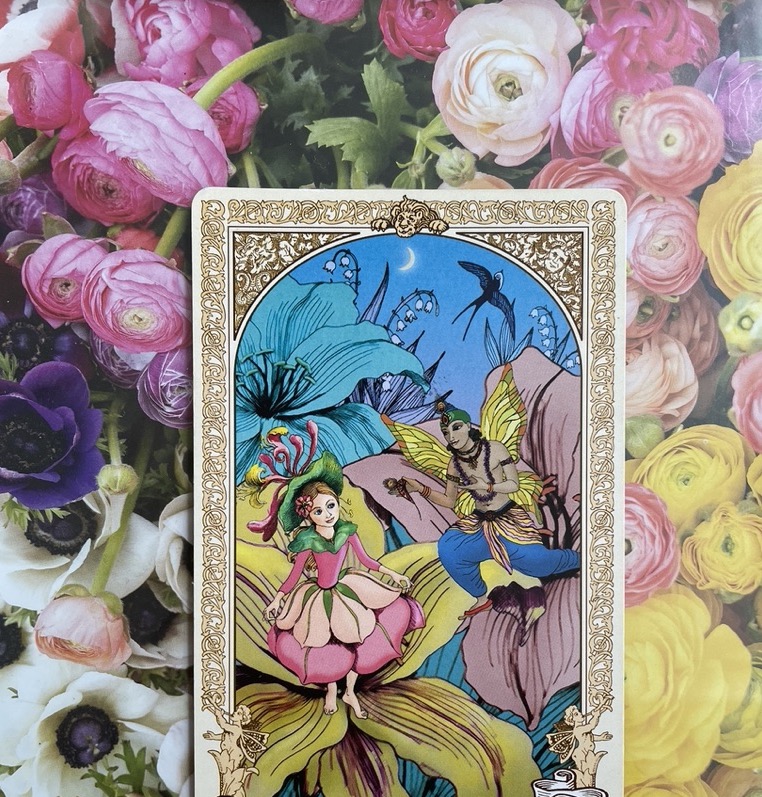
My fairytale card of Thumbelina,
with love,

For more of my writings, browse through my Art of Love.
If you wish to support me, you may do so by sharing my articles and poems, buy my poetry books or donate some magic coins in my hat on Paypal. If you would like to work with me, visit my Offerings.
Your support means so much to me! Thank you wholeheartedly!
Cover photography is by the amazing Su Blackwell, portraying the tale of Thumbelina through her beautiful paper art creations. She official website is linked here. All rights reserved by the artist.

